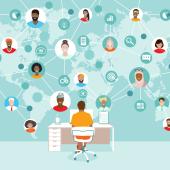
CHEAT SHEET
- Recognize the potential. In-house counsel have the opportunity to expand their understanding of diversity by recognizing the potential of those with disabilities and hiring them.
- Harness the potential. The biopharmaceutical company Merck created a plan to expand its definition of diversity to include disabled people, focusing their efforts on manager training and communication.
- Into the fold. Ernst and Young outline the need for companies to create a positive working environment for disabled employees by planning inclusive events and using proper etiquette to ensure an efficient and respectful workplace.
- Getting to “great.” Patricia David and JP Morgan created a three-to-five year plan outlining the company’s mission to become the most desired by people with disabilities with an intention to be all inclusive.
The idea of using well thought out, written, and documented best practices for diversity and inclusion is commonplace when dealing with race, ethnicity, and gender, but is noticeably absent when we study the population of people with disabilities. Since diversity is defined as “the state of having people who are different races or who have different cultures in a group or organization,” it is evident that from its core, diversity always spoke about race or culture, but rarely discussed those with “other differences.” In its business application, it followed suit that diversity was the word used to describe people with various kinds of “differences” that involved race and culture. As time went on and society evolved, gender was added to the list, so that when a company claimed to be an equal opportunity employer, candidates could rest assured that people of all races, ethnicities, and gender preferences of equal talent would be considered for the same position. Today there are some firms and institutions that have added people with disabilities to the definition of diversity when they search for qualified employees. Unfortunately, the number of these firms is a minority.
Most firms do not include people with disabilities as a minority group recognized under the title of diversity. Since they are not included, they have no protection, guidance, advocacy, or best practices that serve them. For people with disabilities, advocacy has been focused on the law and not on best practices. We believe there is a need to raise the bar by identifying best practices for the hiring, training, retention, and inclusion of people with disabilities. We hope to include people with disabilities as a qualified part of the candidate pool in a diverse and inclusive workforce.
In the United States, when it comes to the employment of people with disabilities in the workplace, the Americans with Disabilities Act (ADA) serves as their primary protection. However, when we look at what the law offers, we realize that it’s not enough, and merely provides the bare minimum of protections that are required when hiring, training, retaining, and including the disabled population. Best practices, on the other hand, offer advances to a potentially limitless ceiling of opportunities that set a higher standard that supports workers to reach their highest potential in the workplace. We want best practices to attract the maximization of talent from the pool of candidates and workers of all abilities.
If we search the US Department of Labor’s website, we can find lists of best practices for hiring and working with employees with disabilities. We can find lists of what should be done to provide minimum requirements set by law. Despite these documents, the implementation of the ADA has not reduced unemployment statistics of disabled workers over the years. Of those that are employed, the majority hold low-level jobs. Some firms have achieved increasing the number of people with disabilities in high-impact jobs. What can we learn from these companies? How have they changed the face and culture of their law departments to include people with disabilities? The answers to these questions can help us to expand diversity and create inclusive goals in an effort to staff the most capable talent to achieve company success.
As an interesting comparison to the United States, there are two models of disability in the United Kingdom: the medical model and the social model. The medical model sees the disabled person as having a personal tragedy, possessing a personal problem, becoming a policy issue, requiring individual adaptations, and needing speacial care. Conversely, the social model views the person with a disability as experiencing social oppression, having a social problem, being a political issue, and needing both social change and civil rights. While the medical model believes that expertise is held by qualified professionals, the social model views expertise based on the experience of the person with the disability. The concept of the social model opens up a whole new avenue of research and approach for firms.
The questions become: Why have people with disabilities overall been exempt from the diversity and inclusion equation and how do we change it? How do we advocate for changing the minimum standard and making it a higher level of best practices in force that will raise the ceiling? How can more firms view the definition of diversity in broader terms, like those firms that have included a broad range of minorities to be included in their work force?
The US Department of Labor claims that “credible, consistent data is critical to creating change.” But even if there is data, how do we use it to increase the employment of people with disabilities? Have firms become adequately structured to meet the needs of people with disabilities so that they can reach their full potential? How do they become prepared to be the conduit to allow these people to reach their maximum personal success as well as contribute to the success of their firm?
On a more personal or individual level, why should you begin to recognize whether there are qualified people with disabilities working for your firm? How can you make changes within your firm’s culture that will encourage people with disabilities to seek employment with your firm? How can your firm enable them to increase personal potential as well as ensure firm profits and company success? Where do we start the discussion? We hope that this article starts to inspire you to ask the questions that are necessary in order to find and work toward solutions.
We can learn from firms and law departments who have already accomplished disability inclusion in their diversity hiring practices. It’s important for firms to realize that the intelligence, determination, drive, and work ethic of their employees has nothing to do with their physical, visible, or invisible challenges. Rather, it has to do with who they are as people, and what skills they bring to the workplace. Meg Cimino, an executive director of legal and compliance with Morgan Stanley, believes that the only thing that people with disabilities may have in excess is a different kind of grit and tenacity than their fellow colleagues. Successful firms know that this grit and tenacity can make people with disabilities even more valuable, motivated, and successful than some of their coworkers who haven’t experienced the same challenges in life.
Not included in the data is the fact that most disabled workers do not want to be defined by their disability. They want to be seen as everyone else — for their abilities and for who they are as people. Jim Kutsch, president of The Seeing Eye and International Guide Dog Foundation, succinctly says, “People with disabilities are either seen as victims or heroes. I don’t want to be seen as either. I don’t know why people refer to me as the blind guy in the room. I mean that’s only one adjective that describes me. I’m also a husband; a father; I have a PhD; I run several organizations; I’m a tandem bike rider. How come I’m seen only as the blind guy?”
Henry Stifel, senior vice president and investment advisor and broker at Morgan Stanley and vice chairman of The Christopher and Dana Reeve Foundation agrees. Stifel, a quadriplegic for over 30 years, loves his work as a wealth manager. He has been with Morgan Stanley for 36 years. He loves his work and clients, and they love and respect him. He is intelligent, works hard, knows his business, and wants to be respected and known for being the best advisor and broker he can be. If he is doing something his clients don’t like, he wants to know that too. He supported his clients well through the financial crisis, and continues to manage a huge portfolio of client wealth. Stifel just wants to be seen as any other person, certainly not as the victim in a wheelchair, or as the hero who gets around in a wheelchair to serve as a deep inspiration to the rest of the world. In Stifel’s words: “It is not my job to be everyone’s inspiration. Let me be the best I can be at what I do. That’s what I’m trained for.”
People with disabilities do not want to be known for and defined by their disabilities, but instead for their abilities, just as the majority of people do. It is Kutsch’s and Stifel’s knowledge that proves their capability in the workplace — their perspective is an asset to their companies. Their experience and education in their respective fields make them outstanding employees. And yet, an additional asset they have is that they think about things differently. Once again, maybe part of it is their grit and tenacity as well as having a different kind of empathy.
Jim Merklinger, vice president and chief legal officer of Association of Corporate Counsel, was on the board of the Tourette’s Association in the Greater Washington area for 10 years. He advocated, both nationally and locally, and believes that his challenges, as well as the unique challenges of others, make them more qualified on the job. People with disabilities have arguably cleared more hurdles before they get to their desk in the morning than the average person, which seems to propel them to make even greater strides in the workplace. Merklinger explains that people with disabilities often view what others consider to be disabilities as responsibilities, which they have accepted and are able to channel positively into their lives. What we need to do in the workplace is merely arm them with the tools they need for complete success. It is not the qualified disabled person who may not be able to handle a job. It is the firm, company, or people on site that may not be able to accommodate people with disabilities. Only a few questions will determine if the workplace offers the appropriate technology, has an appropriate building, chair, computer, or any other workplace accommodation for these workers to get their job done. It is generally not their failure; it is the failure inherent in the workplace that has not been sensitive to the needs of the entire potential qualified diverse employee pool. A workplace should adopt a standard of best practices that are as easily definable and in place as a fire drill procedure.
It is generally the workplace that can’t accept the challenge of hiring people with disabilities, not the qualified disabled candidate that can’t accept the challenge of the job. Stifel, in a wheelchair for over 35 years, has complete knowledge of what he needs to be available to get through any situation. However, does the firm understand those needs, and are they prepared to meet any and all accessibility and accommodation needs that he or any disabled employee may require to reach their potential and achieve maximum success for the firm?
For those with a non-visible disability, how might the firm even know there are accommodations or types of support they can provide if they can’t see what is presented? In the words of Lisa Frank, vice president and assistant general counsel at ADP, and a five-time cancer survivor who wins the battle every day, “Having a non-visible disability helps me to not be defined as ‘the cancer girl’ or ‘you know that lawyer with cancer.’ I have stage four cancer, and unless I tell someone, they likely won’t know. I believe an invisible disability becomes visible when certain attributes appear, like being bald or wearing a scarf around your head so no hair can be seen. That takes the invisible to visible based on people’s assumptions. I could be shaving my head to be chic or wearing a scarf to hide the fact that I haven’t washed my hair recently. People need to ask or listen instead of defining others by what they assume.” Clear and honest communication between the employer and the employee is vitally important.
Takeaways from Earnest and Young
What I learned from Golden, is that E&Y uses the term “work adjustment” in lieu of “accommodation.” She also states “cost is simply not a major barrier to helping our people become productive in our best interest to invest in them and give them the tools they need to do their job effectively.” In addition, when I discussed with Golden a comment made by Stifel regarding his statement that he is not here to be everyone’s inspiration (even though so many feel he is), she agreed. When I also asked her where her colleague could find people with a disabilities who have a PhD in science to fill jobs at Merck, she answered “the same place you look for any talented candidate: from competitors, from clients, and from employment agencies. Most of the qualified people with disabilities are out there working!” Of her most striking bits of advice, Golden believes that “top leadership buy-in is critical…if you can tie accessible technology to organizational goals and strategies, it will be easier to gain support and buy-in from key players….[she also] recommend[s] that companies should not rely on statistics alone to build a business case for accessibility. It has to be about performance, and how accessible technology can make your organization perform at its peak by helping every individual in the organization do his or her best work.”
Let’s look at how some successful companies are doing it and see what we can glean to bring to our own firms.
Merck, the biopharmaceutical company, employs approximately 68,000 people worldwide and understands that consistently harnessing the knowledge and insights of a diverse workforce, inclusive of people with disabilities will deliver more innovative solutions to patients around the world. In 2012, when the then VP and Chief Diversity Officer Deborah Dagit spoke in front of the US Senate Health, Education, Labor and Pensions Committee on employment and disability, at a session titled “Lessons Learned from the Field: Learning From What Works for Employment for Persons with Disabilities” she spoke of some of the strides that Merck had made in the area of bringing disability under the diversity and inclusion umbrella and made further recommendations for others to do the same. Nora Vele, the current executive director of talent insights and compliance for Merck, worked with Dagit for 12 years before Dagit retired. Vele’s passion about being an advocate to continue to expand efforts to include people with disabilities as a vibrant and significant talent pool is palpable. She explains that Merck has a long history of creating a culture of inclusion for people with disabilities, as it was not always given the same value as other diversity demographics. Six years ago, Merck developed a comprehensive strategic platform to address full disability inclusion. The strategy is broken down into four facets which, when combined and used appropriately, will develop a customized pipeline of talent for people with disabilities. These core facets are: disability inclusive culture, building meaningful relationships, talent acquisition, and Merck branding. It is important to note that while these facets are separated by name, the success of one facet will have an impact on the success of another.
US Implications
The following resources are provided for the reader to obtain further understanding of disability policies and regulations within the United States, as well as from the companies highlighted in this article.
US DEPARTMENT OF LABOR DISABILITY RESOURCES
US DEPARTMENT OF LABOR DISABILITY INFORMATION
US DEPARTMENT OF LABOR OFFICE OF DISABILITY EMPLOYMENT POLICY
OFFICE OF DISABILITY EMPLOYMENT - DATA ON THE EMPLOYMENT STATUS OF PEOPLE WITH DISABILITIES
MERCK – GLOBAL DIVERSITY & INCLUSION
ESSENTIAL ACCESSIBILITY HELPS FIRMS BUILD LOYALTY WITH PEOPLE WITH DISABILITIES
MERCK – AN ESSENTIAL ACCESSIBILITY PIONEER
ERNST & YOUNG D&I ROADMAP
DIVERSITY AT JP MORGAN CHASE
JP MORGAN CHASE
THE MUSEUM OF DISABILITY HISTORY - The Museum of disABILITY History is dedicated to advancing the understanding, acceptance and independence of people with disabilities.
THE CHRISTOPHER AND DANA REEVE FOUNDATION
To support their disability inclusion strategy, Merck took a serious look at exactly what work they wanted to focus on. They built a framework to support their plan and it included the following:
- Talent acquisition;
- Retention;
- Manager training and education;
- Communication;
- Marketing strategies;
- Community outreach; and,
- Supplier diversity.
In addition, they have built a strategy for metric and measurement to evaluate, correct, and improve their processes.
Merck built strategic alliances and partnered with national and local organizations, such as the US Business Leadership Network and the National Organization for Disabilities. They continue to look for places and other channels to find a talented pool of employee candidates with disabilities. Where do you find a person with a disability who has a PhD or is a scientist for example? Vele searches for ally networks to find people who would fit the job descriptions available at Merck. She even has a dedicated recruiter who focuses on partnerships with organizations who serve people with disabilities.
Vele is working with a supplier who is disability certified and together they are working on the manager training and education step of their framework to develop a training module through e-learning that will target managers to produce a disability confident workforce. This training module will include role playing vignettes in many areas of disabilities, including depression. Yes, Merck considers mental illness a disability which is to be included in the diversity pool.
Merck views using a social model as the best approach toward creating initiatives for including people with disabilities into the workplace. It connects the interaction between individuals and society. To do so, they ensure accessible work environments and meeting attitudinal barriers head on. They have clear guidelines, have addressed physical access, provide professional development opportunities, supply management training, and work to put their framework into practice throughout the firm’s culture.
Their approach is holistic; their team is dedicated, determined, and passionate. They recruit the best talent from the pool of people with disabilities, just as they recruit the best talent from all pools of people. They clearly are a force that believes in creating best practices for their workforce of all abilities that will allow their employees to reach their potential. They will not settle for the minimum standard set by the law, and will continue to surpass it and reach for the sky. Merck is clearly lucky to have had Dagit, and to have her colleague Vele at the helm of such an important task. It is clear that Vele will continue to make Merck remain at the forefront of winners when it comes to being a leader in advocating for people with disabilities in their goal of achieving a diverse and inclusive workforce. Vele, her colleagues, and Merck have “a belief that employees with disabilities have strengths linked to their limitations that likely offset them, and also that the limitations themselves provide new perspectives that support innovative thinking.”
Ernst and Young (E&Y), an assurance tax and advisory service company, has over 200,000 employees globally. Also at the top of the list of leaders in diversity and inclusion, E&Y works to raise awareness of people with disabilities in the workplace, as well as people of all abilities. Their resources fall into four categories:
- Creating an inclusive environment (which includes a handbook for working with non-visible disabilities, explaining accommodations, helping people think through challenges, communicating effectively with people with disabilities, accessible facilities checklist, posters to raise awareness of non-visible disabilities);
- Events, meetings, and presentations (planning accessible and inclusive events and PowerPoint presentations, conference call etiquette);
- Language and etiquette (appropriate language, being supportive and respectful); and,
- Employment (checklist of leading practices candidates should look for when job searching).
Ernst and Young’s belief in inclusiveness of people with disabilities is clearly a reflection of their global practice in over 150 countries. Their belief that this globalization brings with it a constantly changing diverse workforce and accordingly, offers them unique employees, opinions, cultural awareness, and perspectives that assist them in success in the marketplace. They view it as a part of their leadership role in communities across the globe, not only for their own work force, but for their clients around the world. Their research teaches them that the most diverse working communities realize improved performance, improved market share, stronger collaboration, and increased retention on the job. “…creating an inclusive workforce, where all differences matter, allows us to identify the risks and opportunities we might not otherwise see.”
Fleur Bothwick, OBE, EMEIA director of diversity and inclusive leadership at Ernst and Young, is a strong force behind the success of Ernst and Young’s leadership and success program. She has been awarded an Order of the British Empire for her contributions to diversity and inclusiveness at her company in global offices outside the United States. Bothwick believes that her role is “a catalyst for change” and praises her colleagues’ talents as well. She feels her award reflects “how committed our leaders are to diversity and inclusiveness.” A portion of her work was spent creating a “pilot summer graduate scheme for interns with disabilities” in the United Kingdom. In the United States, it is Lori Golden who is charged with being the abilities strategy leader and executive director. Golden leads the effort to build an enabling and inclusive community for people with disabilities. Some of the initiatives Golden undertakes include:
- Enhancing accessibility in E&Y offices;
- Making all meetings and communications more accessible;
- Building a global accessibility strategy for web and online applications;
- Educating EY employees on disabilities etiquette; and,
- Raising awareness of disability-related issues.
Having spoken with Golden, it is obvious why E&Y has her leading these initiatives in the United States. Golden also advises E&Y’s AccessAbilities professional resource network and the Abilities Champions network of leaders, both of which reach global offices. “Golden is a member of the US Department of Labor’s Circle of Champions, serves on the boards of directors of the US Business Leadership Network (the largest employer-led disabilities organization, and TransCen, a non-profit helping young people with disabilities transition from school to competitive employment.” Golden explains that E&Y was the first of the “Big-Four” accounting firms to sign the Business Disability Forum’s Accessible Technology Charter. The Business Disability Forum seems to have laid the foundation and serves as a guideline for much of Golden’s and E&Y’s work in this area. Golden clearly is a master in the area for people with disabilities in the workforce and strives to keep E&Y as aware and well-schooled as possible to create a diverse and inclusive workplace. This ultimately serves to benefit both their employees and their far-reaching and diverse pool of clients. Also involved with the Taskforce on Accessible Technology and the National Business and Disability Council, E&Y has led the way to encourage other accounting firms to be able to ensure accessible tools that are sold to clients around the globe.
Global implications
The following resources are provided for the reader to obtain further understanding of disability policies around the world.
THE EUROPEAN DISABILITY FORUM
EUROPEAN STATUTES
ACADEMIC NETWORK OF EUROPEAN DISABILITY EXPERTS (ANED)
ETTAD - ENABLING TEACHERS AND TRAINERS TO IMPROVE ACCESSIBILITY OF ADULT EDUCATION
EUROPEAN DISABILITY ACTION PLAN
THE EUROPEAN ACCESSIBILITY ACT
EUROPEAN COMMISSION – EMPLOYMENT, SOCIAL AFFAIRS, AND INCLUSION
OVERVIEW OF DISABILITY IN CHINA
WEB ACCESSIBILITY JAPAN AND ASIA
RUSSIA LAWS ON EQUALITY AND ANTI-DISCRIMINATION
Most of us realize that any company absorbs the culture and beliefs from the top. It wasn’t surprising when I discovered that Arthur Young, the founder of Ernst & Young who was trained as a lawyer, had low vision and was deaf, and therefore could not comfortably practice the law. He thus changed career paths, to accounting, and built a new career for himself. By doing so, imagine all of the people with disabilities he has helped and lives he has changed through the years. Due to his own challenges, he was able to create a workplace culture that embraces differences like his own.
At JP Morgan, another firm leading the top 10 leaders in diversity success, Patricia David serves as managing director and head of global diversity. David is all about making global changes at JP Morgan. Her strategy is different than most. A year ago, David started JP Morgan on a journey to answer this question: If JP Morgan wanted to be the best company for people with disabilities to work for, what would they look like? What would they have to do to be the choice company? What does great look like? Their months of research resulted in a 21 page document that detailed a three to five year plan. It didn’t take 15 minutes for the head of HR and legal to approve the plan. David is on her mission, driving JP Morgan’s Office of Accessibility in the right direction to become great: the firm most desired by people with disabilities. David didn’t wait for the clock to start running on her vision. Immediately, she and her team started pulling “low hanging fruit” and working to have their tech team develop software, update their recruiting team, make changes on campuses, and review their real estate and medical care. The new plan promises to be all inclusive. David seems to be clearly adopting the social model in her plan. Instead of making individual adaptations per person and treating disabilities as personal problems, she is a leader in viewing disabilities as a social agenda that needs and deserves social changes. Speaking with David assures you that she will make those changes, and create a company that has everything in place ready to attract the best candidates with disabilities.
Regardless of the size of your law department or firm, following best practices in the area of inclusiveness for a diverse workplace encourages you to have the highest quality of workforce. Be sure that your diversity initiatives include people with disabilities. It will be from their grit, tenacity, and experience that the quality of your firms will improve and grow. Be proactive. Make changes so that you attract the best possible pool of candidates to join your team. Before bringing employees with disabilities in the door, make your environment one that accommodates workers of all abilities. We can all learn from the many leaders, past and present, who have, some through their own challenges, strived to make their workplace and lives examples of true diversity and inclusion for talented employees and valued clients of all abilities. Join the team of leaders. Strive to be great.
Please share with us if you feel that your company is a leader in the inclusion of people with disabilities under your diversity initiative. Send your contact information or that of your diversity leader to leslie.wolfson@accglobal. com who will be in contact to showcase your company and continue her research and analysis of creating a list of best practices for an ACC toolkit you can use.




